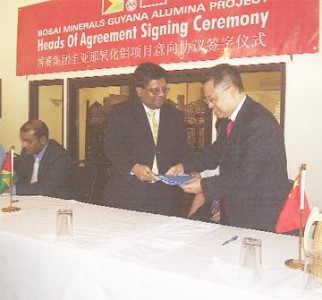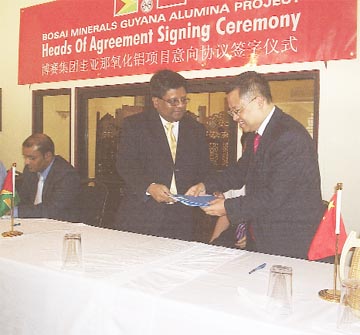An alumina refinery in Guyana moved one step closer to reality with the signing of a Heads of Agreement between Bosai Minerals Group and the Guyana Government yesterday.
The signing clears the way for the way for Bosai to continue to pursue and conclude the feasibility study at a greater level of detail and to determine the financial and economic attractiveness of establishing the one-million-tonne per year alumina plant in the bauxite mining town of Linden.

The US$1 billion project represents the single largest investment in Guyana and is a joint venture between Bosai Minerals Group and the Guyana Government. The name of the project will be the Guyana Alumina Incorporated with the government owning 11% of the shares and Bosai 89%.
Minister of Finance, Dr Ashni Singh and Managing Director of Bosai, Zhilun Yuan signed the agreement in the presence of President Bharrat Jagdeo, Prime Minister Samuel Hinds, other government officials and representatives of Bosai and the Chinese government at Duke Lodge in Kingston yesterday.
Giving an overview of the project, Bosai Manager of International Projects, Jing Kun Fang recalled that in January last, a delegation from the company made the proposal to the government to build an alumina refinery in Linden. He noted that the major objective of the proposal was to have a joint venture between the Guyana Government and Bosai to carry out a substantial alumina refinery operation and government’s response to the proposal was “very positive”.
Jing noted that the feasibility study has to be completed by Bosai and approved by the government and this is expected to be completed in June 2009. Construction is expected to start no later than the end of 2009 or any other date agreed to by the parties, he said, while noting that this was a difficult time for any project of this size so “we want to have some flexibility for construction starting date.”
Construction is expected to take no more than three years and the Bosai International Projects Manager said that during construction about 700 workers would be needed. On completion, the facility would need 1,000 permanent employees for normal operations. For the first ten years, the venture would be exempted from corporation tax.
President Jagdeo, in his feature address noted that there was quite a lot of work to be done before construction began. He said parts of the feasibility study still had to be completed and urged that the moment be recognized for its importance. He expressed his pleasure at the project.
Meanwhile, Zhilun in his remarks said that the company not only wanted to continue its success in the calcined bauxite business but to expand activities in other alumina areas. “The alumina project is our first step in this direction and this signing ceremony marks the first important milestone,” he said, adding that he believed the project would be successful if the Guyana Government and Bosai continued to work closely together to achieve common goals and “if the world economic climate returns to previous levels”.
Stating that Bosai has committed to other long-term development projects in the country, Zhilun said that in addition to the alumina project, Bosai plans to expand Bosai Minerals Group (Guyana) Inc calcined bauxite production capacity within one or two years by adding a third kiln. This kiln, kiln 15, will increase the annual capacity by 50%, from 300,000 tonnes to 450,000 tonnes, he stated.
The Managing Director said that mining capacity will also need to be expanded and if the company continues to gain market share, a fourth kiln will be installed. He asserted that in order to improve the company’s competitive advantage, more Chinese mobile equipment will be brought into service for the expansion process. “We believe the high performance and low cost of the Chinese equipment are key to increasing mining efficiency and to reduce production costs,” he declared.
Additionally, he said, Bosai planned to investigate the possibility of starting mullite production to further diversify the refractory business. “Finally, if cheap hydropower becomes available to Guyana, we plan to expand into down-stream processing of alumina products. One possibility is to produce white-fused alumina and the other is to build an aluminium smelter,” Zhilun said.
He stated that a positive development towards hydropower in Guyana has been seen recently and the Amalia Falls hydro project is making progress. He remarked that at a meeting with the Prime Minister, the possibility of using the extra power of Amalia Falls was discussed. “Guyana is not only rich in bauxite but also in hydro-resources and cheap power should be possible if the resources are fully utilized,” he commented.
Bosai Company Secretary, Norman McLean, referring to the global financial crisis said that it would impact on the ability to execute the project in a timely manner but Bosai has demonstrated a very positive attitude to it. He noted that signing of the agreement will concretize interest expressed by both sides.
Work on the feasibility study is ongoing and it was stated that the majority of the capital for the alumina project is to come from Chinese banks.

